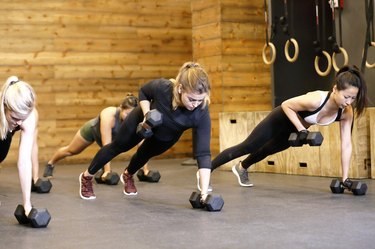
Whether you are aiming to improve your performance in a sport or activity or just want to reap the benefits of physical activity, body conditioning exercises strengthen and improve your body and performance. Body conditioning generally includes aerobic exercise, strength training and stretching and flexibility exercises. The specific exercises you choose will vary depending on your goals.
Tip
A body conditioning exercise is any exercise that improves a physical attribute and may include cardio exercise to burn fat or resistance training to tone muscles.
Video of the Day
Aerobic Conditioning Workouts
Health.gov's Physical Activity Guidelines for Americans recommends that adults get at least 150 to 300 minutes of moderate intensity aerobic exercise each week. This works out to 30 to 60 minutes per day, five days per week.
Video of the Day
Aerobic conditioning strengthens the cardiovascular and respiratory systems of the body and reduces the risk of diseases such as Type 2 diabetes, heart disease, stroke and depression. It is also a critical component in achieving weight loss and maintaining a healthy weight.
If you participate in a sport or activity that requires a higher level of aerobic fitness, such as soccer or long-distance running, you may want to increase the time and intensity of your workouts to help you prepare for that activity. Some activities to consider for your aerobic conditioning include running, bicycling, swimming and climbing stairs.
Strength Conditioning Exercises and Flexibility
For the most health benefits, adults should do strength training exercises for each of the body's major muscle groups at least twice per week, according to the Physical Activity Guidelines for Americans.
Strength conditioning workouts strengthen the musculoskeletal system and improve your ability to do physical tasks such as lifting and carrying items. You can perform strength training exercises by lifting weights at the gym or doing bodyweight exercises such as squats, push-ups and sit-ups.
Read more: The Best Exercises for Every Major Muscle
Stretching exercises help improve your flexibility and range of motion. You can perform stretches on your own or consider a yoga class to help improve your flexibility. Balancing exercises are also important to prevent falls. An activity such as tai chi helps improve balance, or you can practice exercises such as standing on one foot.
Structuring Your Workout
Always begin your workout with a five- to 10-minute warm-up to prepare your body for the body conditioning exercises to come. One way to warm up is to do the exercise you will be doing in your workout at a slower pace. For example, walk or jog slowly to warm up for a run. If you are lifting weights, warm up the muscles you will be working with exercises like arm circles or jumping jacks.
Once you are warmed up, do your planned body conditioning exercises. Do not attempt to do too much when first starting a new body conditioning workout. You may want to consult a trainer to help you develop a program suitable for your current fitness level and goals. Increase intensity slowly and always perform exercises with correct form to avoid injury.
When you are done with your workout, be sure to allow time to cool down so your heart rate returns to normal and your body can recover. Similar to the warm-up, you can perform the same exercise you were doing in the workout at a slower pace and lower intensity.
Read more: 15-Minute Workout for Beginners
Warning
Always consult your doctor prior to beginning a new exercise program to make sure you are healthy enough for exercise.